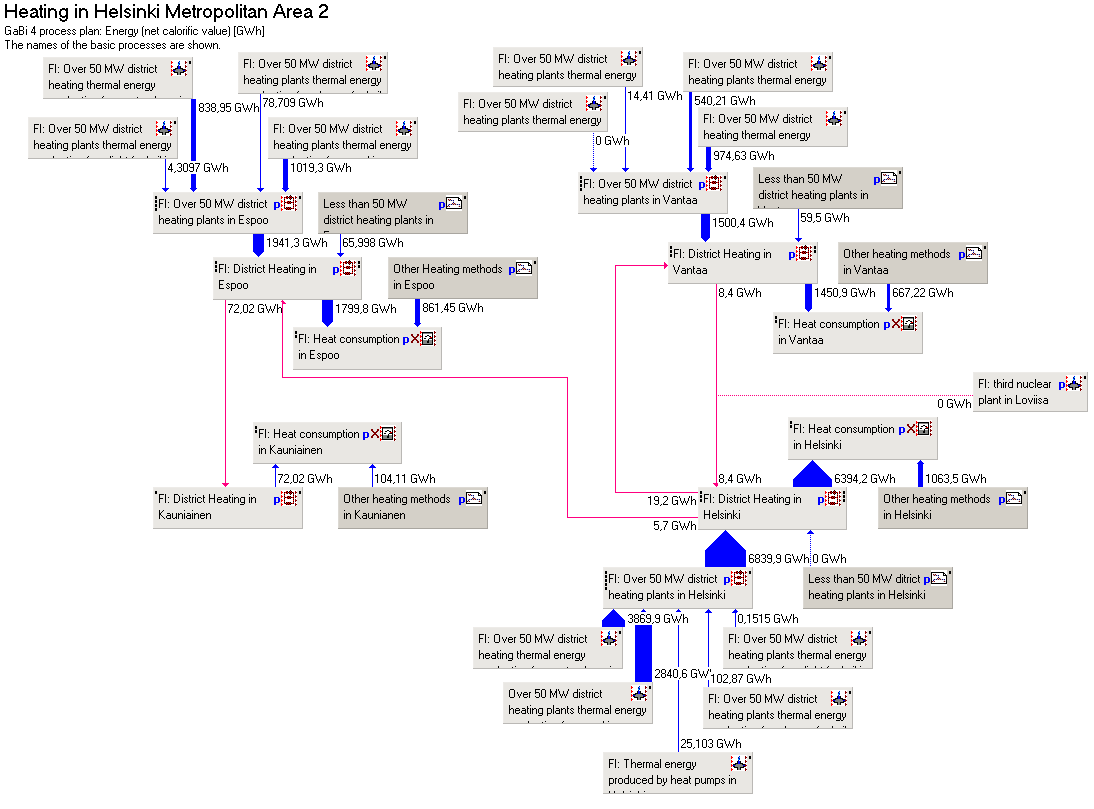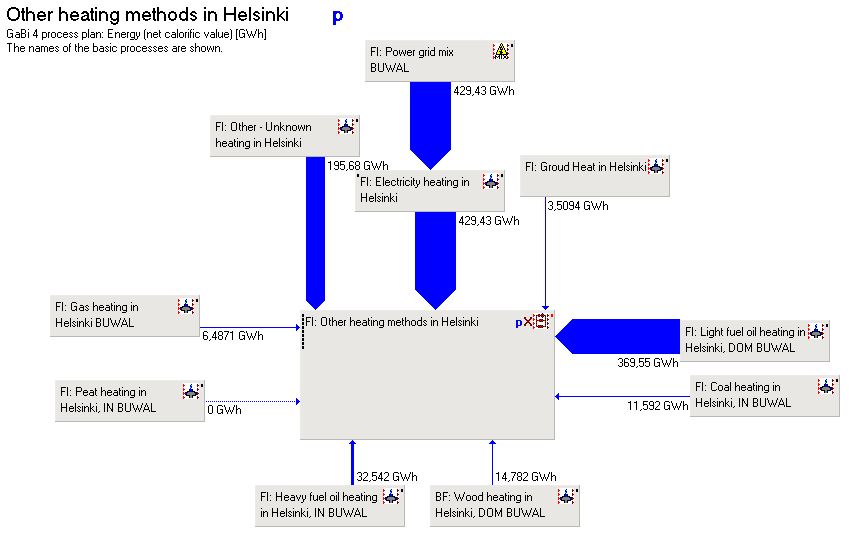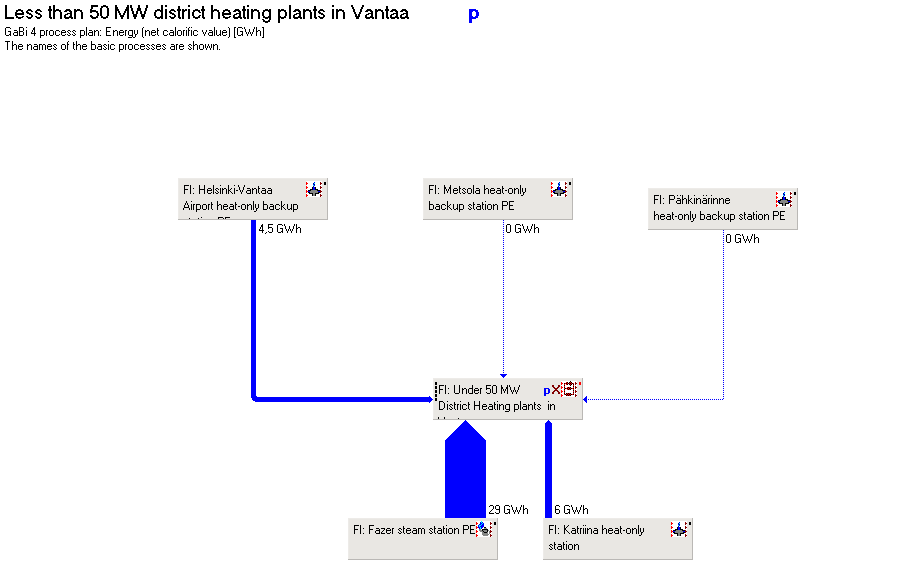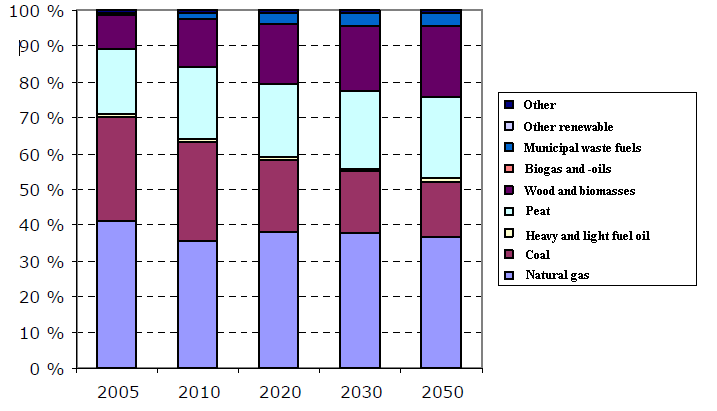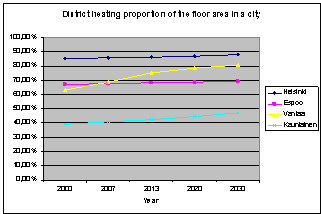Gabi 4.3 - life cycle assessment software: Difference between revisions
mNo edit summary |
|||
| (27 intermediate revisions by 2 users not shown) | |||
| Line 1: | Line 1: | ||
{{encyclopedia}} | {{encyclopedia|moderator = [[User: Psorsa| Psorsa]]}} | ||
[[Category:Life cycle assessment]] | |||
'''Gabi 4.3''' software is versatile program which can be used for life cycle assessment, cost analysis, efficiency analysis, Global Reporting Initiative-reports (GRI) and companies annual reports. Basic idea is to model all the processes, which are needed to create a product. These processes include all the flows, which are needed for manufacturing the product or which are formed because of manufacturing. | |||
The model for small-scale energy production in Helsinki Metropolitan area is made by Gabi 4,3 life cycle assessment program. The basic idea of life cycle assessment is to model every flow and emission from raw material to end of the product. In this case every flow and emission is impossible to model, because vast amount of flows and emissions in energy production, but the main flows and emissions are modeled. | |||
In the model Helsinki Metropolitan area is divided to four areas by the cities; Espoo, Helsinki, Kauniainen and Vantaa. Each city has a process to define need of thermal energy in the city and how much each heating method produces energy, which are calculated based on district heating and floor area statistics and calculations in [[Thermal energy need in Helsinki Metropolitan Area]]. | |||
Use of floor area statistics makes calculation results unreliable, because it is based on building registry. Building registry is not updated, if the change of heating method does not require building permission. This why estimations for other used heating methods fractions are made better by using Haaparanta et all 2003-report of small scale combustion in Helsinki Metropolitan area. | |||
In Haaparanta et all 2003 report is estimated that 44 % in Helsinki, 60 % in Espoo and 66 % in Vantaa of separate residential houses, which does not use wood as main heating source, use wood for supplementary thermal energy production. Main method to produce thermal energy in residential buildings is a thermal energy reserving stove in Helsinki Metropolitan area, 90 % of the thermal energy is produced by this type stove. Almost all the new residential houses are assessed to have a stove for wood use. In the model calculations 153 850 GigaJoules (GJ) of thermal energy is produced in buildings, which use wood as main fuel, and in Haaparanta et all 2003- report total thermal energy produced from wood is estimated to be 945 000 GJ in 2002. The total thermal energy produced from wood can estimated to be significantly higher than the floor area statistics show [Haaparanta et all 2003]. In this study total thermal energy production fraction from wood is estimated to be six times more what the statistics show. Estimation is made based on Haaparanta et all 2003- report. | |||
[ | |||
Helsinki, Espoo and Kauniainen | Amount of district heating production in a city is taken from district heating statistics and a single district heating production unit values from energy company data, those values are reliable. | ||
[[ | |||
Large scale district heating units are not modeled individually like small scale district heating units. Emissions of large scale district heating units are calculated by using fuel information of district heating statistics and emission factors for district heating units are taken from Kivihiilitoimikunta 2004 and Karvosenoja M., 2008 – reports or calculated by using companies emission data. Large scale district heating units are divided to six groups based on the fuel or heat source, which are natural gas, coal, heavy fuel oil, light fuel oil, biogas and geothermal heat. | |||
Possible new nuclear plant is modeled to be in Loviisa, if the plant is build. All the nuclear plant parameters are taken from Fortum’s application for the 6th nuclear plats in Finland. It is estimated to produce energy in 2020 and to produce 1000 MW thermal energy to the district heating network of Helsinki. This would be more than enough to cover total need of thermal energy in Helsinki and some of the needs of thermal energy in Vantaa and Espoo. This would dramatically change energy production in Helsinki metropolitan area and would lower the carbon dioxide emissions considerably, because the fossil fuels would be replaced by nuclear fuel. If the nuclear plant is connected to the district heating network of Helsinki, it would produce excess energy. In the model this excess thermal energy is estimated to be transferred then evenly to the district heating networks of Vantaa and Espoo. Thermal energy flows between district heating networks are modeled also. | |||
In the figure 1 is shown the model in 2007 situation. Shown flows in the figure are thermal energies. Sub-plans for the other used heating methods and small scale district heating unit processes are used to make the model structure simpler. | |||
[[Image:Main.PNG]] | |||
Figure 1. Simplified figure of the gabi-model for the year 2007. | |||
As the figure 1 shows, most of the thermal energy is mainly produced by district heating in cities, except in Kauniainen. District heating is produced mainly from coal and natural gas and produced thermal energies in small scale district heating units is very small in fraction of the total produced thermal energy in a city. In Figure 2 is presented the division of other used heating methods. | |||
[[Image:Other heating methods.PNG]] | |||
Figure 2. Other used heating methods sub-plan of Helsinki. | |||
Division of other used heating methods are made based on floor area statistics, where the other used heating methods are divided to nine groups; coal, geothermal, electricity, heavy fuel oil, light fuel oil, natural gas, peat, wood and other-unknown heating. | |||
Sub-plan of small scale district heating units in Vantaa is shown in figure 3. | |||
[[Image:Small scale DH plants.PNG]] | |||
Figure 3. Sub-plan for small scale district heating units in Vantaa. | |||
Small scale district heating units are individually modeled. Produced thermal energy and emissions are assessed individually for each small scale district heating unit, based on data of energy production companies. | |||
On an assessment of district heating and cooling future in Finland has evaluated future consumption of district heating and cooling up to year 2050 and which fuels will be used to produce the needed district heating. On that assessment demand of district heating is estimated to start decreasing after year 2020 in Finland and the future distribution of used fuels is presented in figure 4. | |||
[[Image:Future fuel use in DH production.PNG]] | |||
Figure 4. Distribution of used fuels in district heating units now and in the future. | |||
Decreasing of district heating consumption probably wont happen in Helsinki Metropolitan area as the calculations shows in [[Thermal energy need in Helsinki Metropolitan Area]], but the increase of district heating consumption is calculated be lower than in the past. | |||
The calculations, Vehviläinen et all 2007-report and Helsinki Metropolitan Council-2003 report is used for future estimations. District heating fraction of total floor area future development in a city has given three scenarios in this model. In base scenario floor area of district heating building is estimated to remain in 2007 level. In scenario 1 floor area of district heating buildings is estimated to keep same fraction of total floor area as in 2007. In scenario 2 floor area of district heating buildings fraction of total floor area is estimated to increase at the same rate as in figure 5. | |||
[[Image:Figure 1.PNG]] | |||
Figure 5. District heating building floor area fraction of the floor area in the future, if estimated that the increase would be as it has been between years 2000 and 2007. | |||
Helsinki Metropolitan Council (YTV) estimates that emission per inhabitant will remain more or less at the same level as today. A heating method fraction of total floor area of other used heating methods is estimated to be same as in 2007 in this study, because there are not studies or calculations of future changes for other used heating methods. | |||
On large scale district heating unit production, YTV estimates that major changes area won’t happen until year 2016 in Helsinki metropolitan, only minor changes on fuel side to less carbon dioxide emissions affecting fuels. Emission trading and clean air for Europe-program will affect pressures to lower the emissions in energy production. | |||
Thermal energy production changes in large scale district heating units are estimated to be as same as in Vehviläinen et all 2007-report. | |||
The model calculates the produced thermal energy for each heating method and district heating unit. When the produced energy is know, can be the emissions calculated by using emission factors and efficiencies of different energy production methods. District heating units emissions are calculated by using emission factors, which are presented in table 1, and district heating of Finland statistics, where is listed fuel use of the district heating companies. For other used heating methods is used estimation in Haaparanta et all 2003-report, where efficiencies of other heating methods are calculated by using statistics of produced energy in Finland 2002. Those calculations are presented in table 1. | |||
Table 1. Efficiencies of other used heating methods | |||
{| {{prettytable}} | |||
| . | |||
| Consumption of energy | |||
| Beneficial energy | |||
| Fraction | |||
| Efficiency | |||
|---- | |||
| . | |||
| TJ | |||
| GWh | |||
| % | |||
| % | |||
|---- | |||
| Wood | |||
| 41400 | |||
| 6325 | |||
| 13 | |||
| 55 | |||
|---- | |||
| Peat | |||
| 510 | |||
| 85 | |||
| 0,2 | |||
| 60 | |||
|---- | |||
| Coal | |||
| 90 | |||
| 15 | |||
| 0,03 | |||
| 60 | |||
|---- | |||
| Heavy fuel oil | |||
| 3330 | |||
| 768 | |||
| 1,6 | |||
| 83 | |||
|---- | |||
| Light fuel oil | |||
| 43100 | |||
| 9338 | |||
| 19 | |||
| 78 | |||
|---- | |||
| Natural gas | |||
| 2020 | |||
| 505 | |||
| 1 | |||
| 90 | |||
|---- | |||
|} | |||
Emission factors, which are used in the model, are presented in table 19. | |||
Table 2. Used emission factors in the model. | |||
{| {{prettytable}} | |||
| . | |||
| Natural gas | |||
| Coal | |||
| Heavy fuel oil | |||
| Light fuel oil | |||
| Wood | |||
| Peat | |||
|---- | |||
| Carbon dioxide [t/MWhfuel | |||
| 0,203 | |||
| 0,34 | |||
| 0,278 | |||
| 0,267 | |||
| 0,409 | |||
| 0,382 | |||
|---- | |||
| PM2,5-factor for large scale district heating plants [kg/MWhthermal] | |||
| 0 | |||
| 0,01476 | |||
| 0,1116 | |||
| 0,00072 | |||
| 0,01476 | |||
| 0,01476 | |||
|---- | |||
| PM2,5-factor for small scale district heating plants [kg/MWhthermal] | |||
| 0 | |||
| 0,108 | |||
| 0,1116 | |||
| 0,00072 | |||
| 0,108 | |||
| 0,108 | |||
|---- | |||
| PM2,5-factor for other used heating methods [kg/MWhthermal] | |||
| - | |||
| - | |||
| - | |||
| 0,00072 | |||
| 2,52 | |||
| - | |||
|---- | |||
|} | |||
<ref>Vantaan Energia 2008. Social responsibility report (in Finnish). Available at http://www.vantaanenergia.fi/tietoa_konsernista/vuosiraportit/fi_FI/vuosiraportit/. Last visit 11.5.2009.</ref> | |||
<ref>Helsingin energia 2008. Vuosikertomus 2007 (In Finnish). Edita Prima Oy. 2008. Available at http://www.helen.fi/vuosi2007/Helsingin_Energia_vuosikertomus_PDF.pdf. Last visit 11.5.2009.</ref> | |||
<ref>Fortum Heat and Power oy 2008. Heat production. Available at http://www.fortum.com/dropdown_document.asp?path=14022;14024;14026;14043;14070;14071;41962;41967. Last visit 11.5.2009.</ref> | |||
<ref>Statistics of Finland 2009. Rakennukset (lkm, m2) käyttötarkoituksen ja lämmitysaineen mukaan 31.12.2007 (in Finnish). Available in http://pxweb2.stat.fi/Dialog/Saveshow.asp. Last visit made in 13.3.2009.</ref> | |||
<ref>Huovilainen, R. T.; Koskelainen L. Kaukolämmitys (in Finnish). Lappeenranta’s university of technology. Lappeenranta 1982. ISBN 951-763-209-6</ref> | |||
<ref>Jalovaara J., Aho J., Hietamäki E. & Hyytiä H,. 2003. Paras käytettävissä oleva tekniikka (BAT) 50 MW:n polttolaitoksissa Suomessa (in Finnish). Suomen ympäristö 649. 126s</ref> | |||
<ref>Korkia-Aho S., Koski O., Meriläinen T. & Nurmio M. 1995. VAHTI – Käsiteanalyysi. Länsi-Suomen ympäristökeskus 29.9.1995. 35s.</ref> | |||
<ref>Adato Energia Oy. 2009. District Heating in Finland 2007 (S). </ref> | |||
<ref>Statistics Finland 2005. Energy Statistics 2004. Energy 2005:2. Helsinki, Finland.</ref> | |||
<ref>Vehviläinen I., Hiltunen J., Vanhanen J., 2007. Lämmön ja sähkön yhteistuotannon potentiaali | |||
sekä kaukolämmityksen ja –jäähdytyksen tulevaisuus Suomessa (in Finnish). Gaia Consulting Oy. | |||
</ref> | |||
<ref>Karvosenoja Niko, 2008. Emission scenario model for regional air pollution. FINNISH ENVIRONMENT INSTITUTE, FINLAND. 2008. ISBN 978-952-11-3185-1. Available at http://www.ymparisto.fi/download.asp?contentid=92446&lan=en. last visit 11.5.2009.</ref> | |||
<ref>Kivihiilitoimikunta. 2004. Kivihiilen käytön hallittu rajoittaminen sähkön ja lämmön tuotannossa. Kauppa- ja teollisuusministeriö.Edita publishing oy. ISBN 951-739-833-6</ref> | |||
<ref>Statistics of Finland 2001. Statistics of energy. Statistics of Finland 2001:2.</ref> | |||
<ref>Aarnio P,. Niemi J., Koskentalo T., Kousa A., Myllynen M., 2008. Ilmanlaatu ja siihen vaikuttavat tekijät pääkaupunkiseudulla. Ilmansuojelu ohjelmien taustatiedot. Metropolitan Area Council (YTV). Valopaino Oy. Helsinki. 2008. 978-951-798-689-2</ref> | |||
<references/> | |||
==See also== | |||
* {{#l:Parameters, gabi-model.xls}} | |||
* [http://www.gabi-software.com/ GaBi website] | |||
* [http://lca.jrc.ec.europa.eu/lcainfohub/database2.vm?dbid=130 EC website about GaBi databases] | |||
* [http://www.pe-international.com/ PE international], GaBi developer. | |||
Previous files used in a Gabi model | |||
* {{#l:Globals.JPG}} | |||
* {{#l:Balance.PNG}} | |||
* {{#l:Balancebutton.JPG}} | |||
* {{#l:Gabianalystbutton.JPG}} | |||
* {{#l:Gabianalyst.JPG}} | |||
* {{#l:Mainplan.PNG}} | |||
* {{#l:Vantaaplan.JPG}} | |||
* {{#l:Assessment of small-scale energy production in Helsinki Metropolitan area.zip}} | |||
* {{#l:Small scale DH plants.PNG}} | |||
* {{#l:Example picture for heat load model.JPG}} | |||
* {{#l:Example picture for duration curve for heat load.JPG}} | |||
* {{#l:Housing stock in Helsinki metropolitan area.xls}} | |||
* {{#l:Heat load in Helsinki metropolitan area housing stock.JPG}} | |||
* {{#l:Gabi.JPG}} | |||
Latest revision as of 16:55, 23 March 2015
This page is a encyclopedia article.
The page identifier is Op_en2788 |
|---|
| Moderator: [[category:Moderator: Psorsa]][[user: Psorsa| Psorsa]] [[moderators# Psorsa|(see all)]] |
|
|
| Upload data
|
Gabi 4.3 software is versatile program which can be used for life cycle assessment, cost analysis, efficiency analysis, Global Reporting Initiative-reports (GRI) and companies annual reports. Basic idea is to model all the processes, which are needed to create a product. These processes include all the flows, which are needed for manufacturing the product or which are formed because of manufacturing.
The model for small-scale energy production in Helsinki Metropolitan area is made by Gabi 4,3 life cycle assessment program. The basic idea of life cycle assessment is to model every flow and emission from raw material to end of the product. In this case every flow and emission is impossible to model, because vast amount of flows and emissions in energy production, but the main flows and emissions are modeled.
In the model Helsinki Metropolitan area is divided to four areas by the cities; Espoo, Helsinki, Kauniainen and Vantaa. Each city has a process to define need of thermal energy in the city and how much each heating method produces energy, which are calculated based on district heating and floor area statistics and calculations in Thermal energy need in Helsinki Metropolitan Area.
Use of floor area statistics makes calculation results unreliable, because it is based on building registry. Building registry is not updated, if the change of heating method does not require building permission. This why estimations for other used heating methods fractions are made better by using Haaparanta et all 2003-report of small scale combustion in Helsinki Metropolitan area.
In Haaparanta et all 2003 report is estimated that 44 % in Helsinki, 60 % in Espoo and 66 % in Vantaa of separate residential houses, which does not use wood as main heating source, use wood for supplementary thermal energy production. Main method to produce thermal energy in residential buildings is a thermal energy reserving stove in Helsinki Metropolitan area, 90 % of the thermal energy is produced by this type stove. Almost all the new residential houses are assessed to have a stove for wood use. In the model calculations 153 850 GigaJoules (GJ) of thermal energy is produced in buildings, which use wood as main fuel, and in Haaparanta et all 2003- report total thermal energy produced from wood is estimated to be 945 000 GJ in 2002. The total thermal energy produced from wood can estimated to be significantly higher than the floor area statistics show [Haaparanta et all 2003]. In this study total thermal energy production fraction from wood is estimated to be six times more what the statistics show. Estimation is made based on Haaparanta et all 2003- report.
Amount of district heating production in a city is taken from district heating statistics and a single district heating production unit values from energy company data, those values are reliable.
Large scale district heating units are not modeled individually like small scale district heating units. Emissions of large scale district heating units are calculated by using fuel information of district heating statistics and emission factors for district heating units are taken from Kivihiilitoimikunta 2004 and Karvosenoja M., 2008 – reports or calculated by using companies emission data. Large scale district heating units are divided to six groups based on the fuel or heat source, which are natural gas, coal, heavy fuel oil, light fuel oil, biogas and geothermal heat.
Possible new nuclear plant is modeled to be in Loviisa, if the plant is build. All the nuclear plant parameters are taken from Fortum’s application for the 6th nuclear plats in Finland. It is estimated to produce energy in 2020 and to produce 1000 MW thermal energy to the district heating network of Helsinki. This would be more than enough to cover total need of thermal energy in Helsinki and some of the needs of thermal energy in Vantaa and Espoo. This would dramatically change energy production in Helsinki metropolitan area and would lower the carbon dioxide emissions considerably, because the fossil fuels would be replaced by nuclear fuel. If the nuclear plant is connected to the district heating network of Helsinki, it would produce excess energy. In the model this excess thermal energy is estimated to be transferred then evenly to the district heating networks of Vantaa and Espoo. Thermal energy flows between district heating networks are modeled also.
In the figure 1 is shown the model in 2007 situation. Shown flows in the figure are thermal energies. Sub-plans for the other used heating methods and small scale district heating unit processes are used to make the model structure simpler.
Figure 1. Simplified figure of the gabi-model for the year 2007.
As the figure 1 shows, most of the thermal energy is mainly produced by district heating in cities, except in Kauniainen. District heating is produced mainly from coal and natural gas and produced thermal energies in small scale district heating units is very small in fraction of the total produced thermal energy in a city. In Figure 2 is presented the division of other used heating methods.
Figure 2. Other used heating methods sub-plan of Helsinki.
Division of other used heating methods are made based on floor area statistics, where the other used heating methods are divided to nine groups; coal, geothermal, electricity, heavy fuel oil, light fuel oil, natural gas, peat, wood and other-unknown heating.
Sub-plan of small scale district heating units in Vantaa is shown in figure 3.
Figure 3. Sub-plan for small scale district heating units in Vantaa.
Small scale district heating units are individually modeled. Produced thermal energy and emissions are assessed individually for each small scale district heating unit, based on data of energy production companies.
On an assessment of district heating and cooling future in Finland has evaluated future consumption of district heating and cooling up to year 2050 and which fuels will be used to produce the needed district heating. On that assessment demand of district heating is estimated to start decreasing after year 2020 in Finland and the future distribution of used fuels is presented in figure 4.
Figure 4. Distribution of used fuels in district heating units now and in the future.
Decreasing of district heating consumption probably wont happen in Helsinki Metropolitan area as the calculations shows in Thermal energy need in Helsinki Metropolitan Area, but the increase of district heating consumption is calculated be lower than in the past.
The calculations, Vehviläinen et all 2007-report and Helsinki Metropolitan Council-2003 report is used for future estimations. District heating fraction of total floor area future development in a city has given three scenarios in this model. In base scenario floor area of district heating building is estimated to remain in 2007 level. In scenario 1 floor area of district heating buildings is estimated to keep same fraction of total floor area as in 2007. In scenario 2 floor area of district heating buildings fraction of total floor area is estimated to increase at the same rate as in figure 5.
Figure 5. District heating building floor area fraction of the floor area in the future, if estimated that the increase would be as it has been between years 2000 and 2007.
Helsinki Metropolitan Council (YTV) estimates that emission per inhabitant will remain more or less at the same level as today. A heating method fraction of total floor area of other used heating methods is estimated to be same as in 2007 in this study, because there are not studies or calculations of future changes for other used heating methods.
On large scale district heating unit production, YTV estimates that major changes area won’t happen until year 2016 in Helsinki metropolitan, only minor changes on fuel side to less carbon dioxide emissions affecting fuels. Emission trading and clean air for Europe-program will affect pressures to lower the emissions in energy production.
Thermal energy production changes in large scale district heating units are estimated to be as same as in Vehviläinen et all 2007-report.
The model calculates the produced thermal energy for each heating method and district heating unit. When the produced energy is know, can be the emissions calculated by using emission factors and efficiencies of different energy production methods. District heating units emissions are calculated by using emission factors, which are presented in table 1, and district heating of Finland statistics, where is listed fuel use of the district heating companies. For other used heating methods is used estimation in Haaparanta et all 2003-report, where efficiencies of other heating methods are calculated by using statistics of produced energy in Finland 2002. Those calculations are presented in table 1.
Table 1. Efficiencies of other used heating methods
| . | Consumption of energy | Beneficial energy | Fraction | Efficiency |
| . | TJ | GWh | % | % |
| Wood | 41400 | 6325 | 13 | 55 |
| Peat | 510 | 85 | 0,2 | 60 |
| Coal | 90 | 15 | 0,03 | 60 |
| Heavy fuel oil | 3330 | 768 | 1,6 | 83 |
| Light fuel oil | 43100 | 9338 | 19 | 78 |
| Natural gas | 2020 | 505 | 1 | 90 |
Emission factors, which are used in the model, are presented in table 19.
Table 2. Used emission factors in the model.
| . | Natural gas | Coal | Heavy fuel oil | Light fuel oil | Wood | Peat |
| Carbon dioxide [t/MWhfuel | 0,203 | 0,34 | 0,278 | 0,267 | 0,409 | 0,382 |
| PM2,5-factor for large scale district heating plants [kg/MWhthermal] | 0 | 0,01476 | 0,1116 | 0,00072 | 0,01476 | 0,01476 |
| PM2,5-factor for small scale district heating plants [kg/MWhthermal] | 0 | 0,108 | 0,1116 | 0,00072 | 0,108 | 0,108 |
| PM2,5-factor for other used heating methods [kg/MWhthermal] | - | - | - | 0,00072 | 2,52 | - |
[1] [2] [3] [4] [5] [6] [7] [8] [9] [10] [11] [12] [13] [14]
- ↑ Vantaan Energia 2008. Social responsibility report (in Finnish). Available at http://www.vantaanenergia.fi/tietoa_konsernista/vuosiraportit/fi_FI/vuosiraportit/. Last visit 11.5.2009.
- ↑ Helsingin energia 2008. Vuosikertomus 2007 (In Finnish). Edita Prima Oy. 2008. Available at http://www.helen.fi/vuosi2007/Helsingin_Energia_vuosikertomus_PDF.pdf. Last visit 11.5.2009.
- ↑ Fortum Heat and Power oy 2008. Heat production. Available at http://www.fortum.com/dropdown_document.asp?path=14022;14024;14026;14043;14070;14071;41962;41967. Last visit 11.5.2009.
- ↑ Statistics of Finland 2009. Rakennukset (lkm, m2) käyttötarkoituksen ja lämmitysaineen mukaan 31.12.2007 (in Finnish). Available in http://pxweb2.stat.fi/Dialog/Saveshow.asp. Last visit made in 13.3.2009.
- ↑ Huovilainen, R. T.; Koskelainen L. Kaukolämmitys (in Finnish). Lappeenranta’s university of technology. Lappeenranta 1982. ISBN 951-763-209-6
- ↑ Jalovaara J., Aho J., Hietamäki E. & Hyytiä H,. 2003. Paras käytettävissä oleva tekniikka (BAT) 50 MW:n polttolaitoksissa Suomessa (in Finnish). Suomen ympäristö 649. 126s
- ↑ Korkia-Aho S., Koski O., Meriläinen T. & Nurmio M. 1995. VAHTI – Käsiteanalyysi. Länsi-Suomen ympäristökeskus 29.9.1995. 35s.
- ↑ Adato Energia Oy. 2009. District Heating in Finland 2007 (S).
- ↑ Statistics Finland 2005. Energy Statistics 2004. Energy 2005:2. Helsinki, Finland.
- ↑ Vehviläinen I., Hiltunen J., Vanhanen J., 2007. Lämmön ja sähkön yhteistuotannon potentiaali sekä kaukolämmityksen ja –jäähdytyksen tulevaisuus Suomessa (in Finnish). Gaia Consulting Oy.
- ↑ Karvosenoja Niko, 2008. Emission scenario model for regional air pollution. FINNISH ENVIRONMENT INSTITUTE, FINLAND. 2008. ISBN 978-952-11-3185-1. Available at http://www.ymparisto.fi/download.asp?contentid=92446&lan=en. last visit 11.5.2009.
- ↑ Kivihiilitoimikunta. 2004. Kivihiilen käytön hallittu rajoittaminen sähkön ja lämmön tuotannossa. Kauppa- ja teollisuusministeriö.Edita publishing oy. ISBN 951-739-833-6
- ↑ Statistics of Finland 2001. Statistics of energy. Statistics of Finland 2001:2.
- ↑ Aarnio P,. Niemi J., Koskentalo T., Kousa A., Myllynen M., 2008. Ilmanlaatu ja siihen vaikuttavat tekijät pääkaupunkiseudulla. Ilmansuojelu ohjelmien taustatiedot. Metropolitan Area Council (YTV). Valopaino Oy. Helsinki. 2008. 978-951-798-689-2
See also
 Parameters, gabi-model
Parameters, gabi-model- GaBi website
- EC website about GaBi databases
- PE international, GaBi developer.
Previous files used in a Gabi model
 Globals
Globals Balance
Balance Balancebutton
Balancebutton Gabianalystbutton
Gabianalystbutton Gabianalyst
Gabianalyst Mainplan
Mainplan Vantaaplan
Vantaaplan Assessment of small-scale energy production in Helsinki Metropolitan area
Assessment of small-scale energy production in Helsinki Metropolitan area Small scale DH plants
Small scale DH plants Example picture for heat load model
Example picture for heat load model Example picture for duration curve for heat load
Example picture for duration curve for heat load Housing stock in Helsinki metropolitan area
Housing stock in Helsinki metropolitan area Heat load in Helsinki metropolitan area housing stock
Heat load in Helsinki metropolitan area housing stock Gabi
Gabi
